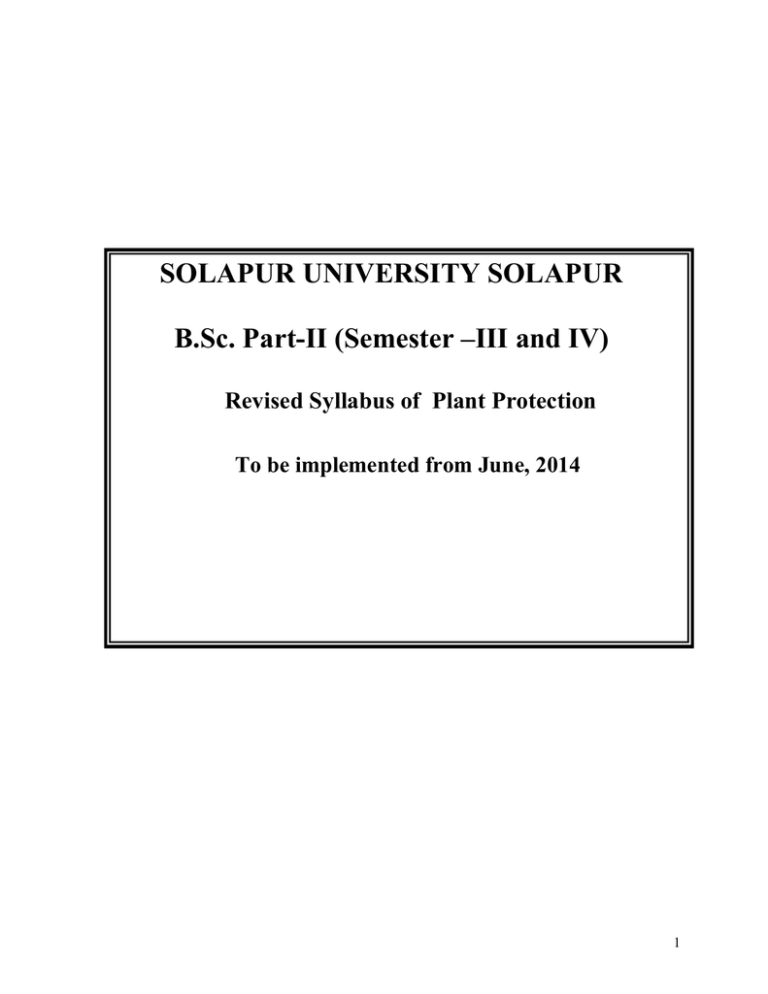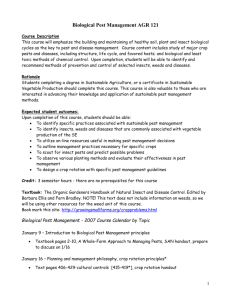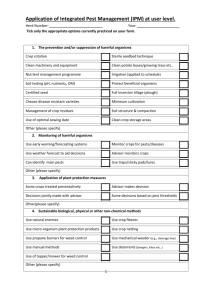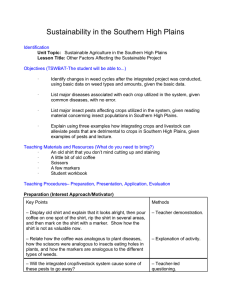SOLAPUR UNIVERSITY SOLAPUR B.Sc. Part-II (Semester –III and IV)
advertisement

SOLAPUR UNIVERSITY SOLAPUR B.Sc. Part-II (Semester –III and IV) Revised Syllabus of Plant Protection To be implemented from June, 2014 1 Solapur University, Solapur B.Sc. Part – II (Plant Protection) Syllabus. To be implemented from June 2014 There shall be two papers of 50 marks each for each semester. Theory examination will be held at the end of each semester and practical exam will be held at the end of the academic year. The details of course are as follows. Structure of the Course A) Semester -III Marks =100 a) Theory Paper I: Major crops and methods of integrated plant protection Marks=50. b) Theory Paper II: Crop Diseases and their Management Marks=50 . B) Semester-IV Marks =100 a) Theory Paper III: Introduction to weeds & non insect pests. Marks=50 b) Theory Paper IV: Insect pests and their Management Marks=50 C) Practical Course: Marks =100 Practical - I (Based on Paper-I and II) Marks =50 Practical – II (Based on Paper-III and IV) Marks = 50 The practical course is to be covered in 50 practicals. The practicals are divided in to two heads-like- Practical –I (Based on Paper- I and -II) and practical –II (Based on Paper –III and IV). Each practical head comprises 25 Practicals.The practical examination shall be conducted at the end of semester –IV on two successive days lasting for more than five hours. 2 Paper titles Semester-III Paper I - Major crops and methods of integrated plant protection. Paper – II- Crop Diseases and their Management Semester-IV Paper-III) - Introduction to weeds & non insect pests Paper-IV) -Insect pests and their Management - Equivalence of the Revised and Pre revised papers:Sr.No Pre-revised Marks Re-vised Marks Semester –III 1 Paper-I 50 Paper –I 50 2 Paper-II 50 Paper-II 50 Semester-IV 3 Paper –III 50 Paper III 50 4 Paper- IV 50 Paper- IV 50 5 Practical – I &II 100 Practical – I &II 100 3 SOLAPUR UNIVERSITY, SOLAPUR SYLLABUS OF B.Sc. II (PLANT PROTECTION) To be implemented from June – 2014 SEMESTER-III PAPER – I Major Crops and Methods of integrated plant protection Unit-1) Introduction and significance of Plant Protection. 45 Periods (02) Unit-2) Study of following major crops of Maharashatra with reference to gross morphology for crop identification, soil types, preparatory tillage, seed rate and spacing, Intercultural operations, fertilizers, Irrigation Intercropping, yield and economic importance: (15) A Cereals - Jowar, Wheat, B) - Oil Seed Crops - Ground nut, Sunflower. C) - Pulse crops - Tur, Gram D) - Cash crops - Sugarcane, Cotton E) - Fruit crops - Mango, Grapes F) - Vegetable Crops - Brinjal, Cabbage G) - Floriculture - Rose, Gerbera. Unit-3-Advanced Methods of Agricultural Practices (6) 3.1) Role of organic farming in Agricultuire. 3.2) Definition and Types of Biofertilizers and their applications Unit-4)-General Methods of Plant Protection: 4.1 Cultural Methods - Tillage, sowing and planting dates, crop hygiene, crop rotation, trap crops, fertilizer 4.2 Mechanical Methods (4) Field sanitation: For diseases – collection and destruction of diseased plant-debris; for pests-hand picking and destruction of egg masses; shaking of plants, rope dragging, netting, bagging, physical barriers, use of sticky bands, tin-bands and light traps (6) 4.3 Physical Methods - Heat and soil solarizations (1) 4 Unit-5) Methods of Management of Insect pests and diseases. 5.1 Chemical Methods - Brief account and uses of Bactericides, Fungicides, Insecticides, Nematicides, Acaricides, Molluscicides, Rhodenticides and Herbicides. 5.2 Biological Control - (5) Introduction, biological control of Insect pests and diseases 5.3 (3) Legal (Plant - quarantine) Introduction, domestic quarantine, need of plant Quarantine in India 5.4 (2) Crop Resistance - General account of use of resistant varieties Paper-II Crop Diseases and their Management (1) (Total 45 Lecture periods) Unit-1)(a)Crop diseases Definition and concept of Plant disease. (1) (b) Terminologies in plant Pathology – Host, Pathogen, Pathogenicity, Pathogenesis, Symptoms, Infection, Incubation period Susceptibility, Immunity, Hypersensitivity, Resistance (5) Unit-2)(A)Classification of Plant Diseases – Based on a) Pathogens, b)Symptoms, c) Severity of disease(sporadic, epidemic and epiphytotic;) d)transmission of pathogens through seed, soil, air and insects (B) Methods of studying Plant Pathogens 2.1 Isolation 2.2 Methods of Inoculation 2.3 Incubation 2.4 Reproduction of disease 2.5 Koch’s postulates (5) (6) 5 Unit-3) Mechanism of Plant Infection 3.1 Mode of infection 3.2 Factors affecting the infection 3.3 Etiology (6) Unit-4) Study of following crop diseases and their management 4.1) Diseases caused by Phytoplasma (2) a) Little leaf of Brinjal b) Grassy shoot of Sugarcane 4.2) Diseases caused by Viruses (2) a) Yellow vein mosaic of Okra (Bhendi) b) Leaf curl of Chilli 4.3) Diseases caused by Bacteria (2) a) Citrus canker b) Bacterial wilt of tomato/chilli 4.4) Diseases caused by Fungi (7) a) Powdery Mildew of Cucurbits b) Downy Mildew of Grapes c) Rust of Soybean d) Rust of Groundnut e) Grain smut of Jowar f) Early blight of Tomato Unit-5)(A)Assessment of diseases in Crop Plants 5.1 Qualitative Methods 5.2 Quantitative Methods (B) Principles of Plant disease management (3) (6) a) Exclusion b) Eradication c) Protection (Physical, Chemical) d) Resistance 6 SEMESTER-IV PAPER – III–Introduction to Weeds and Non Insect Pests - 45 Periods Unit-1) Weeds: A )Weeds – Definition and losses caused by weeds (2) B) Classification of weeds based on – a) Ontogeny b) Ecology c) Crop association (3) Unit-2- Reproduction and mode of dispersal of weeds (2) Unit-3- Study of special weeds: (2) 3.1)-a) Parasitic weeds b) Aquatic weeds c) Poisonous weeds 3.2). Study of following weeds with reference to: a) Gross morphology b) Reproductive ability d) Dispersal Unit-4) 4.1) (10) c) Ecology e) Management of weeds 1. Parthenium hysterophorus 5. Amaranthus spinosus 2. Argemone mexicana 6. Alternanthera tenella 3. Portulaca oleracea 7. Cyperus rotundus 4. Euphorbia hirta 8. Cynodon dactylon Methods of weed management: - Cultural methods: - Ploughing, Hoeing, Hand Weeding, Field Sanitation, Crop rotation, Mulching, cover crops. 4.2) (4) Biological methods: - Weed management by bacteria, fungi and Insects. (2) 7 4.3) Chemical methods: - Classification of weedicides on the basis of chemical nature, mode of action on the basis of range of effectiveness 4.4 ) (2) Study of weedicides with reference to properties, mode of action, formulation and use of i) 2, 4 – D, ii) Glyphosate, Pendimethalin (Stomp 30 EC), Alachlor (Lasso 50 E.C.) Unit-5) 5.1 (8) Study of Non-insect pests: Nematodes – Phytopathotgenic nematodes, mode of infestation, typical life cycle pattern, Meloidogyne symptoms and management. (2) 5.2 Snails and slugs – Nature of damage & their management (2) 5.3 Mites – Morphology damages in storage and field and their management (2) 5.4 Birds – Nature of damage / losses and management (2) 5.5 Rat – Damage / losses caused by different species of Rat in Storage and field and their management Paper-IV-Insect Pests and their management. (2) 45 Periods- Unit-1) Introduction to Insect pests: 1..1.) Definition and loss (qualitative and quantitative) caused by Insect pests. (2) 1.2.) General characters of typical Insect with respect to a) Mouth parts. b) Wings (Venetion, coupling apparatus) c) Types of legs d) abdomen (structure, Segment, appendages) 1.3) Classification of Insect pests based on. (3) (3) a) Nature of damage b) Mouth parts c) Metamorphosis 8 Unit-2).Study of following Insect pests of different crops with reference to a) Scientific name, b) Marks of identification, c) Host range d) Life cycle, e) Carryover, f) Nature of damage and management. 2.1) Crop Pests: a) Jowar - Stem borer b) Sugarcane - Wooly aphids c) Groundnut - White grubs d) Gram - Pod borer e) Mango - Jassids f) Brinjal - Fruit borer g) Tomato - Red Spider h) Rose - Thrips (15) Unit-3) Stored grain pests and their management. (4) a) Rice Weevil and b) Pulse beetle Unit-4. Management of insect Pests- . 4.1)Principles of Insect pest control (1) 4.2) Causes of insect assuming pest status (2) 4.3) Classification of Insecticides based on: (9) (a) Mode of entry – Stomach Contact (b) Mode of Action – Respiratory and Nervous system (c) Chemical Nature – (i) Inorganic (ii) Organic – Chlorinated Hydrocarbons, Organophosphates, Carbamets, Synthetic pyrethroids, (iii) Plant origin insecticides 9 (d) Nature of Formulation – Emulsifiable, concentrates, Dusts. Granules Wettable power. Unit-5(A)-.Recent trends in pest management – a) Attractants, b) Repellents, d) Pheromones, e) Chemosterilants f) Microbial insecticides. (4) c) Antifeedents, (B)Precautionary measures used during pesticide applications.. (2) Solapur University, Solapur Practicals in Plant Protection at B.Sc. Part-II (Semester Course) (To be implemented from June-2011) A) Practical Examination Instructions: Each candidate must produce a certificate from the Head of the Department stating that he/she has completed practical course in satisfactory manner as recommended by Board of Studies and Laboratory Journal has been properly maintained. Every candidate must have recorded his/her observations in the laboratory journal and written report on each exercise performed. Every journal is to be checked and signed periodically by a teacher in-charge and certified by the Head of the Department at the end of academic year. Candidates have to produce their journals at the time practical examination without which he/she will not be allowed to appear for practical examination. B) Excursions: There should be frequent visits to local areas for the study of crop plants, weeds, insect pests, crop diseases; non insect pests etc and report should be submitted. One of the excursions shall be to a research institute or Agricultural centers actively engaged in plant protection studies for not more than five days. There shall be one teacher in-charge for not more than 16 students and one additional lady teacher, one field collector and one peon are to be allowed for study Tour. T. A. and D. A. be paid to the concerning staff as per University rules. 10 C) Field Diary/Field Note Book: Each candidate must maintain a field diary/field note book as per the format provided and it should be certified from the in charge teacher and Head of the department. D) Submission: Candidate should submit the following record at the time of practical examination. 1. Certified Laboratory Journal 2. Tour report 3. Certified field diary / field note book 4. Submission of preserved or dry specimens of diseased plants (at least ten), preserved insect pest (at least three), herbaria of weeds (at least ten), (Candidates will be orally examined for their submission work.) Distribution of Marks Practical – I (Based on Paper-I and –II) Marks-50 1) Study of diseases of crops 16 2) Preparation of Culture/medium/inoculation/isolation 06 3) Micrometry 05 4) Identification of Crops (Agronomy) and pesticides (each with four Marks) 08 5) Field diary/field note book 10 6) Journal 05 Total Practical – II (Based on Paper-III and –IV) 50 Marks -50 1) Study of weeds 06 2) Study of insect pest 08 3) Chromatography 05 4) Soil pH/Sucrose percentage 04 5) Mode of reproduction and dispersal of weeds 02 6) Insect preservation Techniques 02 7) Herbicidal action on weed seed germination 02 11 8) Use of sprayer/duster 02 9) Preparation of pesticides / calibration of sprayer 04 10) Submission 10 11) Tour Report 05 Total 50 Field diary / Field note book For preparing field diary / Field note book at least two field visits each in Kharif and Rabi seasons shall be arranged. During the visit candidates have to collect the data as per format. Format for field note book – 1. Name of the locality / farm visited and date 2. Name of the crops observed or varieties. 3. Season 4. Soil type 5. Cultivation methods 6. Manures/fertilizers dose used 7. Irrigation practices 8. Intercropping / mixed cropping (if any) 9. Weeds associated with crop/s 10. Diseases observed 11. Insect pests observed 12. Control measures/Management practices 13. Performance of Crop 14. Remarks 15. Name of the Candidate 16. Signature of the In-charge teacher 17. Signature of the head of the department. 12 SOLAPUR UNIVESITY, SOLAPUR B.Sc. Part – II –Practical Examination MARCH / APRIL – 20 PLANT PROTECTION PRACTICAL – I Date- Centre- Time: 11.00 am onwards Marks: 50 N.B.: Draw neat labeled sketches wherever necessary. Q. 1 : Identify and describe symptoms of the specimen (12) ‘A’ and ‘B’ (Leave your preparation for inspection) Q. 2 Q. 3 : : a) Prepare and sterilize culture medium PDA/NA (03) b) Isolation and inoculation of pathogen from specimen ‘C’ (03) Measure the given fungal spore from specimen ‘D’ with the help of micrometry technique. Q. 4 : (05) Identification a) Identify the crop and describe the agronomical conditions of specimen ‘E’ and ‘F’ (04) b) Identify and describe the symptoms of specimen ‘G’ and ‘H’ (04) c) Comment on the properties and uses of ‘I’ and ‘J’ (04) Q. 5 : Journal- (10) Q. 6 : Field Note Book (Submission) (05) 13 SOLAPUR UNIVESITY, SOLAPUR B.Sc. Part – II Practical Examination MARCH / APRIL – 20 PLANT PROTECTION PRACTICAL – II Date- Centre- Marks 50 Time: 11.00 am onwards N. B.: Draw neat labeled sketches wherever necessary. Q. 1 : Identify and describe taxonomy, gross morphology, reproduction, dispersal and management of specimen ‘A’ and ‘B’ Q. 2 : (06) Sketch and label the damaging stage in life cycle of specimen ‘C’ and ‘D’ Comment on nature of damage, marks of identification and its management. (06) Q. 3 Q. 4 : : Find out the amino acid composition in E1 and E2 with the help of Circular paper chromatography. (Show your results to the examiner.) (05) Find out Sucrose percentage in F1 and F2 by hand refractometer (04) or Q. 4 : Find out pH of given soil samples, F1 and F2. (04) Q. 5 : Solve the given problem on calibration of sprayer/preparation of pesticide solution. Q. 6 : (04) Identification. a). Give marks of identification of specimen G. (02) b). Give scientific name, host range and management of specimen H. (02) c). Mode of reproduction and dispersal of specimen – I (02) d) Comment on herbicidal action in experiment – J (02) e) Comment on use and working of – K (02) Q. 7 : Tour report- Q. 8 : Submission (10) (05) 14 Solapur University, Solapur B.Sc. Part-II (Plant Protection) Semester Course Practical-I 1 -4) Agronomic studies of following crops with reference to gross morphology for crop identification, agronomic conditions: Jowar, Wheat, Gram, Groundnut, Sunflower, Tur, Sugarcane, Mango, Brinjal, Tomato. 5-16) Study of following diseases in crop plants with reference to host, causal organism, symptoms and management. A. Phytoplasmal diseases a) Little leaf of Brinjal b) Grassy shoot of Sugarcane B Viral diseases a) Yellow vein mosaic of Okra (Bhendi) b) Leaf Curl of Chilli C Bacterial diseases. a) Citrus canker (gram staining) b) Bacterial wilt of Tomato / Brinjal / Chilli (gram staining & Oozing) D Fungal Diseases a) Powdery mildew of cucurbits b) White rust of Amaranthus / Crucifers c) Rust of soybean d) Brown rust – (Puccinia graminis – tritici.) on Wheat e) Grain smut of Jowar f) Early blight of tomato 17-18) Preparation and Sterilization of a) Nutrient Agar (N.A.) b) Potato Dextrose Agar. (P.D.A.) 15 19-20) Isolation of pathogen from diseased plant (Koch’s postulates) a) Inoculation b) Incubation c) Reproduction of Symptoms (Select any one suitable disease – eg. Early blight of tomato (Alternaria solani), Brown leaf spot of rice (Drechslera oryxae), Leaf spot of Crucifers (Alternaria brassicola) Leaf spot of maize (Helminthosporium maydis).) 21-22) Study of Pesticides with reference to chemical nature, characters properties mode of action and uses. (At least two from each group.) Groups – Bactericides, Fungicides, Nematicides, Ascaricides, Insecticides, Rhodenticides, Herbicides. 23) Micrometry of fungal spores (Any suitable material) 24-25) Field visits (25 Practicals) Practical – II 1-3) Study of following weeds with reference to gross morphology for identification, reproduction, dispersal and management. A. Dicot weeds a) Argemone mexicana b) Protulaca oleracea c) Parthenium hysterophours d) Amaranthus spinosus e) Alternanthera tenella F) Euphorbia hirta g) Striga lutea B. Monocot Weeds a) Cyperus rotundus b) Cynotis cristata c) Commelina benghalensis d) Cynodon dactylon 4-5) Study of weeds reference to reproduction and ecology. A. Estimation of seeds by seeds by seed count method. a) Argemone mexicana b) Celosia argentia c) Portulaca oleracea or any locally available weed B. Study of mode of dispersal in following weeds: 16 a) Parthenium hysterophorus b) Tridax procumbens c) Vernonia cinerifolia d) Xanthium strumarium e) Alternanathera tenatea f) Achyranthus aspera g) Cynodon dactylon 6) Action of Herbicides (2,4 ,D./Glyphosate) on germination of seeds of Amaranthus viridis or Protulaca oleracea or Argemone mexicana 7-8) Techniques of collection and preservation of insect pests – a) Wet preservation b) Dry preservation c) Technique of collection and disposition of weeds 9-16) Study of following Insect pests with reference to scientific name, host range; A) life cycle, marks of Identification, nature of damage and management. Crops infested Name of the pest a. - Jowar - Stem borer b. - Sugarcane - Wooly aphids c. - Gram - Pod borer d. - Mango - Jassids e. - Brinjal - Fruit borer f. - Tomato - Leaf miner g. - Rose - Thrips B Study of stored grain pests with reference to above points as in - A Rice weevil, Pulse beetle C Study of root knot nematode of vegetable with reference to above points as in - A 17) Separation of amino acids from healthy and diseased plant using Circular paper chromatography technique. 18) Determination of Sucrose percentage in healthy and infected fruits by hand refractometer. 17 19) Determination of pH of two soil samples. 20) Preparation of pesticides for applications 21) Calibration of the sprayer. 22-23) Study of pesticide application equipments. a. Duster - Hand rotary duster. b. Sprayer - Knap-sac Sprayer 24-25) Field diary (25 Practicals) 18 References Paper – I “Major Crops, Methods of Integrated Plant Protection Paper- II – Crop Diseases and their management Sr. Name of the Book No. Author (s) 1 Agronomy V. J. Vaidya et. al. 2 Biofertilizers in Agriculture Subba Rao 3 Commercial Vegetable Growing Tindall 4 Crop Production and Field Experimentation 5 Cropping System and Theory Chattarjee 6 Floriculture Waurie and Ries 7 Handbook of Agriculture IARI, New Delhi 8 High Yielding Varieties of Crops Mahabal Rani 9 Identification of Crop Varieties Agarwal 10 Irrigation Michael 11 Plant Pathology R. S. Malhaotra 12 Plant Protection Mukundan 13 Principles and Procedures of Plant Protection Chattopadhyay 14 Roses Tony Gregory 15 Scientific Crop Production Mathur 16 Sugarcane C. N. Babu 17 Sugarcane Cultivation M. G. Jadhav 18 The Culture of Vegetables and Flowers from Seeds and Roots Martin Sutton 19 Vegetable growing in India P. S. Arya Prakash 20 Chemistry of insecticides and Fungicide D. S. Sreeramalu 21 Disease of Crops Plants in India Rangaswami 22 Fungi and Diseases in Plants Butler 23 Fungicides in Disease Control Y. L. Nene Vaidya, Shahastrabuddhe and Khupse 19 24 Introduction to Plant Viruses C. L. Mandahar 25 Plant Diseases and Epidemiology Narayanan 26 Plant Diseases Singh 27 Plant Diseases Mathur 28 Plant Diseases Gopa S. Dasgupta 29 Plant Pathogens Singh R. S. 30 Plant Pathologist Pocket Book EMI 31 Plant Pathology P. D. Sharma 32 Plant Pathology Walker 33 Post Harvest Technology of Cereals, Pulses and Oilseeds Chakravarty 34 Viruses and Mycoplasma Diseases of Plants Ray Chaudhari ReferencesPaper III : “Introduction to Weeds, Non-insect Pests Paper-IV- Insect Pests and their ManagementSr. Name of the Book No. Author (s) 1 Agriculture Pests of India and Southeast Asia Atwal 2 An Introduction to Entomology P. D. Srivastava 3 Entomology Pramod Kumar 4 General Entomology M. S. Mari 5 Insect Pests of Crops Pradhan and Jotwam 6 Introduction of Pest Management Dhaliwal and Arora 7 Introduction of Insect Pest Management Metculf 8 Modern Entomology Tembhare Abstract of 8th All Union 9 Nematode Diseases of Agricultural Crops 10 Pest Control Van Emden 11 Plant Protection (Principles and Practice) Mukundan J. R. Conference 20 12 Principles of Weed Science Rao V. S. 13 Scientific Weed Management Gupta O. P. 14 Weed Control and as Science Klingmom 15 Weed Science Thakur 16 Weeds of the World King 17 World Guide to Insects Vol. I & II Packard A. S. Other Reference Books: Sr. No. 1 Name of Book Author Plant Disease Epidemiology Nagrajan 2 Experimental and Conceptual Plant Pathology Singh et.al. 3 Weed Weedicides and Weed control Principle and Practice R. C. Mandal 4 Soils and Soil Management Gustafson 5 Concepts in Integrated Pest Management Nori is et. al. 6 Seed Science and Technology Lab manual Mc Donald & Copeland 7 Seed Technology Agrawal 8 Vegetable Crops Vol. I & II ed Bose et. al. 9 Hand Book of Horticulture ICAR, K. L. Chadha 10 Commercial Flowers – Vol. I, II Bose et. al. 11 Fruits – Tropical & Subtropical – Vol. I Bose et. al. 12 Irrigation Micheal 13 14 15 16 17 18 Plant Protection and Pest Management Application of Pesticides to crops Stored Grain pests & Pest Management Weed Science – Principles Plant – diseases A Text Book of Entomology 19 Principles of Insect Pest Management 20 Plant Pathology Dr. Shubhrata R. Mishra Graham A. Mathews B. P. Khare R – Jaya Kumar Rajni Sharma B. D. Patnaik G. S. Dhaliwal & Ramesh Arora B. P. Pandey 21 SOLAPUR UNIVERSITY ,SOLAPUR (Nature of Question Paper (Plant Protection) (B Sc-Part-II- Paper-I, II, III, & IV) (Faculty Of Science) (W .e .f. June 2014) Time: 2 hrs. Q.No.1) Q.No.2) Multiple choice questions. 1) --------------------------------------------a) - b) c) d) 2) 3) 4) 5) 6) 7) 8) 9) 10) Answer any Five of the following i) ii) iii) iv) v) vi) Q.No.3) A) Answer any Two of the following i) ii) iii) B) Write the Answer/Solve/Problem/Note Q.No.4) Answer any Two of the following i) ii) iii) Q.No.5) Answer any one of the following i) ii) Total Marks: 50 (10) (10) (06) (04) (10) (10) 22 23





